| Cas No.: | 1883510-31-3 |
| Chemical Name: | ML327,ML-327,ML 327 |
| Synonyms: | ML327,ML-327,ML 327 |
| SMILES: | C1C=CNC(=O)C=1C(=O)NCCCNC(=O)C1=NOC(C2=CC=CC=C2)=C1 |
| Formula: | C19H18N4O4 |
| M.Wt: | 366.37 |
| Sotrage: | 2 years -20°C Powder, 2 weeks 4°C in DMSO, 6 months -80°C in DMSO |
| Description: | ML327 is a blocker of MYC which can also de-repress E-cadherin transcription and reverse Epithelial-to-Mesenchymal Transition (EMT). |
| In Vivo: | ML327 treatment significantly reduces tumor volume by three-fold over the two-week treatment period (p=0.02). Tumor explant weights are approximately three-fold smaller in the ML327-treated mice (p=0.01). Mice treated with ML327 lost 12% more body weight than vehicle treated mice. ML327 treatment results in a two-fold decrease in MYCN expression, confirming that ML327 inhibits xenograft MYCN expression (p=0.0035)[1]. |
| In Vitro: | Treatment with ML327 induces an elongated morphology in neuroblastoma cells. BE(2)-C cells treated with ML327 demonstrates G1 cell cycle arrest with a concordant decrease in S phase population, and a significant increase in the sub G0 population. ML327 induces the expression of CDH1 in all seven of the neuroblastoma cell lines with a 50 to 1,400-fold induction of CDH1 mRNA expression. ML327 blocks the expression of MYC family of oncogenic transcription factors in all tested neuroblastoma cell lines. Immunoblotting time course demonstrates early repression of N-MYC expression within 2 h of treatment with ML327 (10 µM). p53 levels are also suppressed by treatment with ML327. ML327-pretreated cells demonstrates reduced proliferative potential in both tetrazolium-based (p<0.0001) and adherent 2D colony formation (41 vs. 400; p<0.0001)[1]. ML327 reduces SW620inv cell invasion through Matrigel by ~60% and reduces H520 cell invasion by ~30% in these in vitro assays. ML327 partially restores E-cadherin expression at the plasma membrane in NMuMG cells induced to undergo Epithelial-to-Mesenchymal Transition (EMT) by TGF-β1 treatment[2]. |






















